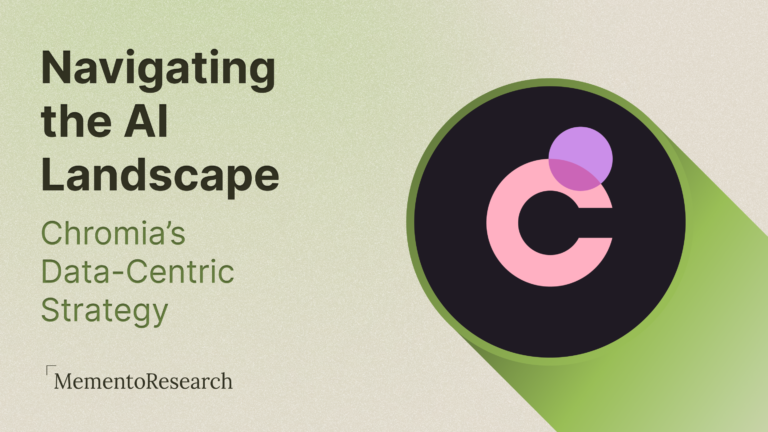Chromia is a Layer-1 relational blockchain platform built to power high-performance decentralised applications (dApps) with a scalable, modular framework that separates the settlement and execution layers. The network leverages on decentralised computational resources and hosting capabilities to enable a flexible, efficient and secure dApp development environment.
Report Scope Summary
This report will cover:
- Key challenges currently faced by the Web3 industry.
- An overview of Chromia’s technology stack, highlighting its unique features.
- Insights into how Chromia is positioned to integrate AI capabilities and drive innovation in dApp development in an increasingly data-centric world.
Current Industry Challenges
Blockchain technology has made significant strides, fostering the growth of decentralized applications (dApps) in sectors like DeFi, Social-Fi, and more. While early blockchains, like Ethereum’s EVM, established the foundation for dApps with general-purpose smart contracts, they face limitations with data-intensive applications requiring advanced processing and complex data management.
Limitations of Traditional EVM
Conventional public blockchain such as Ethereum’s EVM lacks optimization for efficient data handling due to their reliance on the Merkle Patricia Tree (MPT) for encode key-value pairs. This structure presents 2 key challenges:
- Limited Query Flexibility
- Restrictive Data Organisation
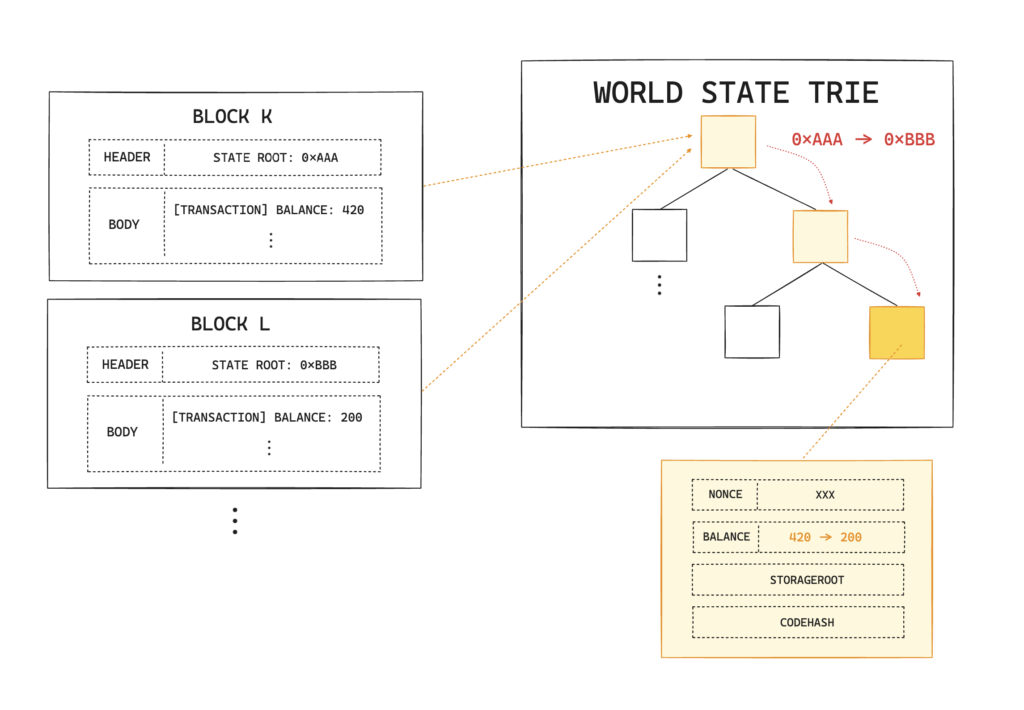
Ethereum MPT Authenticated Storage Illustration
The MPT ensures data validity and integrity through hash-authenticated storage, but proves inadequate for applications demanding complex queries or management of large datasets. These limitations may not be apparent for simple dApps, but poses as a significant huddle for complex applications with higher technical demands.
While the EVM’s key-value storage is efficient for simple transactions, it struggles with complex data management.
Gaming Example
In a complex MMORPG, managing a player’s inventory with numerous items, each with unique attributes and dependencies, becomes challenging. The existing simple key-value structure makes it difficult to express relationships and interactions between items based on the permitted actions in the game.
Querying or updating interconnecting data points simultaneously is nearly impossible in this structure, which require workarounds that often resort to ‘hybrid on-chain off-chain’ models – a gap that Chromia’s relational model is designed to fill seamlessly.
Chromia Technical Stack: Deep Dive
Chromia adopts a relational blockchain model built on PostgreSQL, merging the strengths of a SQL database with the decentralization and security of blockchain. This architecture offers an intuitive development environment that pairs the reliability and familiarity of a tried-and-true database foundation, with the robust features of blockchain technology.
Why a Relational Database?
Relational databases are the most widely used and dominate the global Database Management System (DBMS) landscape.
The top three most popular SQL-based systems and solutions collectively represent over 60% of the DBMS landscape (Source: TOPBDB Top Database Index 2022):
- Oracle (32.09%)
- MySQL (16.64%)
- SQL Sever (13.72%)

Most Popular Databases 2022 – Source: StatisticsAndData
Notably, 7 out of the top 10 DBMS in 2022 are relational databases, highlighting the extent of collectively institutionalisation and familiarity most developers are have with relational DBMS.
Chromia’s use of a relational model aims to streamline developer onboarding experience, while enable a new primitive – to be able to perform complex queries directly on-chain akin to what is achievable with traditional cloud infrastructure in Web2 applications.
Chromia’s Unique Approach
Chromia adopts a ‘Divide and Conquer’ approach that splits its architecture into various specialised chains optimised for its specific function with independent state updates. This enables horizontal scalability while maintaining overall system coherence and performance.
The goal for Chromia’s underlying model are to achieve:
- Efficiently Store Data: By using predefined relationships, data is stored consistently with minimal redundacy.
- Enable Flexible Operations: Complex queries and fast data processing support large data sets, ideal for intensive applications.
Interconnected Chain Infrastructure
Chromia’s Postchain framework enables a composable and extensible setup where a single database can support multiple blockchains. This structure significantly simplifies blockchain interactions by facilitating efficient cross-chain queries, which reduces overall system complexity and enhances interoperability.
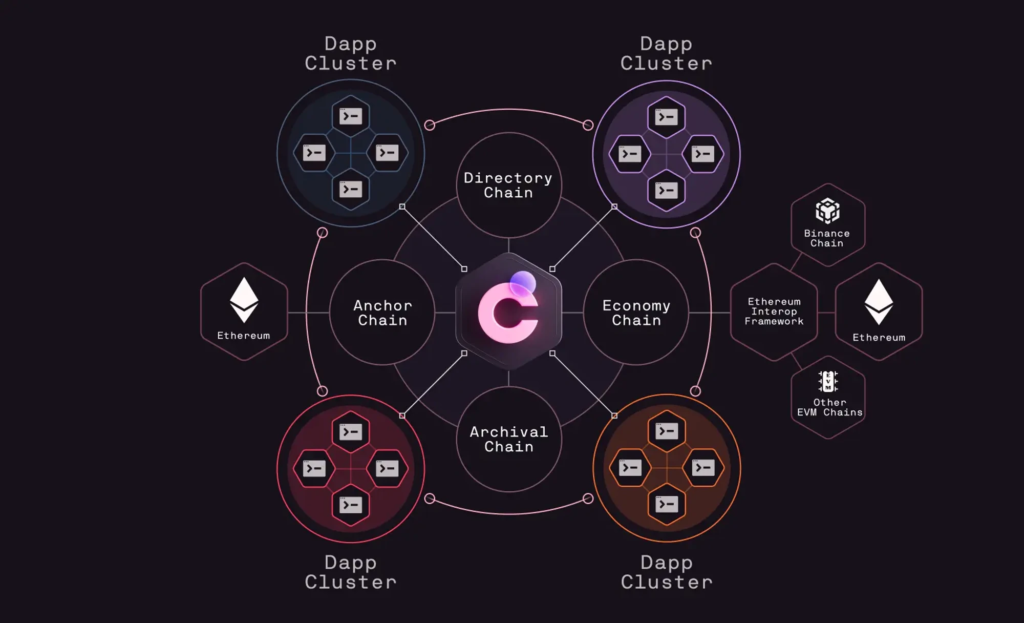
Chromia Interconnected Chain Infrastructure Overview – Source: Chromia Documentation
The core architecture is divided into core foundational chains that collectively power the system, facilitating horizontal scaling across the network:
- Directory Chain: Central registry for providers, nodes, and blockchain configurations across the network.
- Cluster Anchoring Chains: Tracks blocks generated by dApps within each cluster and ensures a consistent production of anchoring blocks for network integrity.
- System Anchoring Chain: Serves as the central hub for verified data across all clusters, facilitating data integrity and security via consensus dispute resolution.
- Economy Chain: Hosts native fee operations, distribution of provider rewards, and dApp payments through economic model – serving as the root chain for CHR tokens and supports the CHR/EVM bridge.
Interoperability via ICMF and ICCF
Chromia utilises its native ICMF (Inter-chain Messaging Framework) to manage internal cross-chain communications for dApp state updates and data synchronisation. This operates through an event publish-subscribe method, where chains are able to publish messages on specific topics for the respective chains to subscribe to.
On the other hand, the ICCF (Inter-Chain Cross-Chain Framework) implemented with Chromia’s FT4 token standard, is responsible for transaction proof constructions for cross-chain asset transfers. Once submitted by a client to the receiving chain, these proofs are verified via its anchor structure.
DApp Optimisation
DApps on Chromia operates on its own dedicated side-chain operated by a set of nodes using a slightly adapted version of Practical Byzantine Fault Tolerance (PBFT) consensus, known as the eBFT. DApps here utilise a database-centric approach to handle complex queries and indexing. This design allows applications to scale independently, with its own set of validators ensuring consensus on all state updates. As a result, each dApp can benefit from:
- Roughly 1 second confirmation time for near-instant finality
- Consistent transaction cost
- More than 500 transactions per second (TPS)
- Over 100,00 reads and writes per second
This setup ensures dApps achieve high throughput and responsiveness, making Chromia an ideal platform for data-intensive applications.
Comparison to EVM Vertical Scaling
In contrast to popular parallel execution models like Sei v2 or Monad which rely on optimistic execution, this solution still presents its own drawbacks on state update optimisation associated with non-modular designs.

Transaction Lifecycle in the Event of Optimistic Parallelisation Conflict – Source: Sei v2 Blog
Optimistic parallel execution means that running transactions in parallel may not guarantee its success due to potential state conflicting scenarios. This would then require re-execution and de-confliction if state updates conflict. Even though research by Paradigm suggests that up to 80% of Ethereum’s storage slots are accessed independently, this process still introduces latency overhead.
Chromia avoids these inefficiencies through its modular network of system chains architecture, which guarantees conflict-free, parallel task execution from the outset.
Efficient Resource Allocation via Customization
Different applications will inherently have its own demands for resources. Thus, a one-size-fits-all distribution model for service provider fees would ineffectively cause underutilisation and overextension of computational resources.
Chromia addresses this with a diverse array of node types tailored specific requirements – from application requirements, service provider capacity to hardware available. This enables an adaptable hosting fee model, optimised around the native CHR token, that ensures effective and balanced resource allocation across the network.
The Ultimate Goal for Chromia
Chromia’s entire system is built to address the scaling limitations of general-purpose blockchains like Ethereum, which often struggle to scale for complex, computationally intensive dApps.
Its modular framework enables both vertical and horizontal scaling solutions, allowing for adaptable resource allocation tailored to support:
- High-performance dApps that require low-latency operations and scalable data management.
- Computationally intensive tasks and high-throughput requirements, especially for applications like multiplayer games and social networks that manage terabytes of data and frequent state updates.
By emphasising these capabilities, Chromia creates a unique environment that empowers scalable, complex dApp development.
Rell Language
Chromia’s native development language, Rell, combines 1) SQL-like simplicity as an Object-Relational Mapping (ORM) tool with modern programming versatility, alongside with (2) safely enhanced underlying operations to enable secured execution of queries/state updates.
Rell Structure

Structure of DApp built in Rell – Source: Chromia Documentation
In Chromia, the DBMS resides within the network of nodes, separate from the client. For data management operations, end users or applications communicate with the client, which then sends transactions to Rell via a Postchain client.
Development Familiarity
Rell offers a developer-friendly learning curve – designed with syntax and structures inspired by widely-used modern programming languages like JavaScript and Kotlin, while integrating relational programming concepts that are intuitive for developers who are mostly familiar with SQL.
This makes it easier for developers to adopt familiar relational idioms.
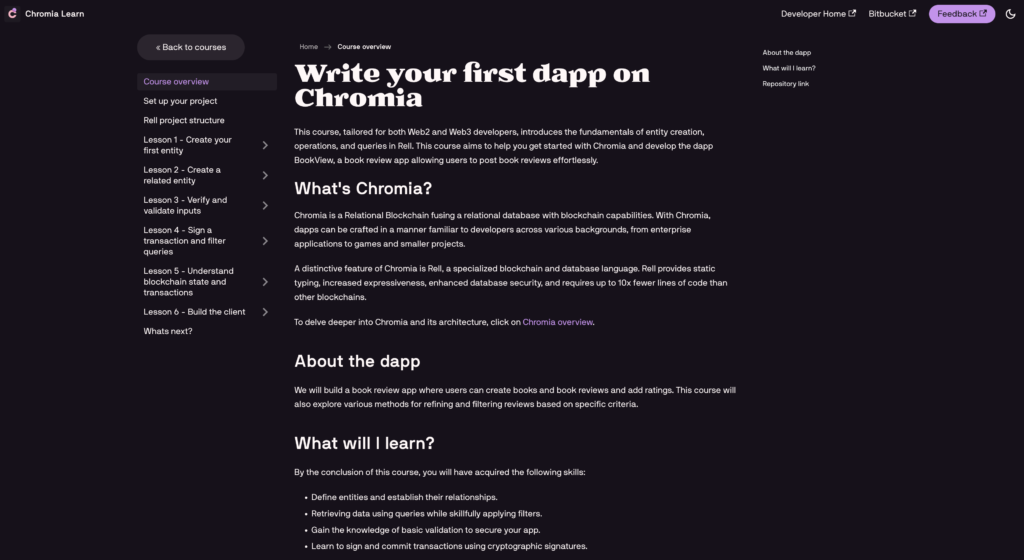
Chromia Learn Documentation Site – Source: Chromia Learn
To support this transition, Chromia provides a comprehensive learning platform to facilitate developers in acclimating to and apply SQL-based programming conventions and principles in Rell.
Combining the accessibility of modern language structures with SQL’s powerful data querying capabilities makes it easier for developers to dive into blockchain programming.
Code Simplicity
Rell is optimised to abstract as much code complexity as possible while maintaining its ability to tap on the capabilities an underlying relational structure.
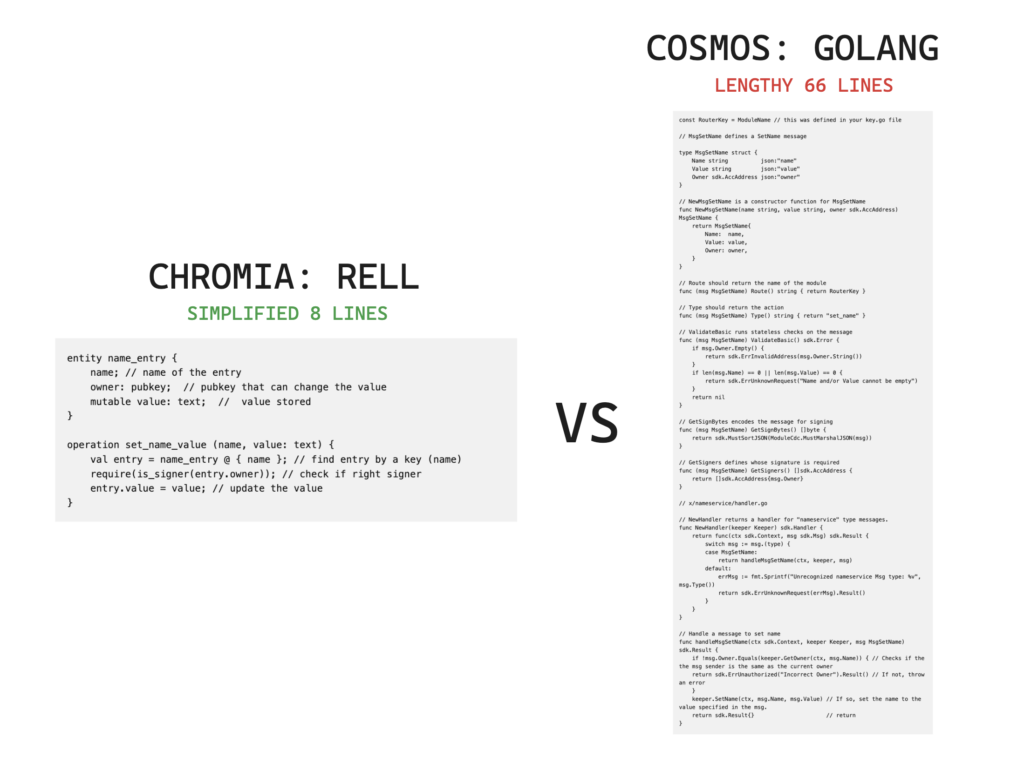
Notably, Rell’s code simplicity not only offers syntax compactness up to 7x compared to the usual SQL, it is also much concise in code implementation compared to existing languages supported on alternative general-purposed programming blockchain such as Cosmos’ Golang. This succinctness enables cleaner writing of code and much shorter development durations.
Technical Data Management Enhancements
Leveraging the power of relational databases is crucial for scalability, but other considerations such as code security and safe programming practices are equally important – especially for applications that require precise and secure fund management.
Chromia’s Rell is designed to go beyond just scalability. The language framework incorporates a robust foundation of static type checks and safety optimisations to enhance security, minimising risks associated with low-level operations such as arithmetic calculations that frequently lead to smart contract vulnerabilities and potential fund loss.

Rell Enhancement Features – Source: Chromia Documentation
Safe and Optimised Execution
Rell’s code is equipped with robust safety optimisations and static type checks when processed by Chromia’s virtual machine, which translates queries into SQL and safely executes them on Chromia nodes.
Bootstrapping Foundational Codebase
To further support developers, the Chromia team has also introduced a comprehensive set of foundational templates. These templates offer pre-vetted secure code to simplify the development process, reducing the need for building everything from scratch and lowering entry barriers for new developers.
By combining the benefits brought about by relational databases with Rell’s simplicity and security, Chromia delivers an unmatched development environment for creating complex, scalable dApps.
Chromia’s Developer Objectives
Rell language aims to bring an intuitive and safe developer experience to enable a seamless DX with an easy onboarding curve and wealth of accessible learning resources. Combined with Chromia’s robust infrastructure capabilities, this creates an ideal environment where developers can efficiently build dApps that perform at scale.
Future-proofing with AI
The rapid evolution of AI, primarily driven by Web2 giants like OpenAI, Meta, DeepMind, and Google, highlights the increasing demand for better decision-making, predictive analytics, and operational efficiency across industries. Yet, traditional cloud-based AI models come with inherent limitations due to centralization and limited accountability, opening a critical opportunity for a more transparent, decentralized approach to AI development.
At its heart, there lies the one fundamental element: Data.
Key Challenges in AI Development
While AI can unlock tremendous value, the opacity of data used to train AI models presents a significant concern, particularly in industries where accuracy and accountability are essential.
The ‘black box’ nature of many AI models can obscure data origins, bias, and quality – leading to unpredictable and potentially harmful results. The potential risks associated with data include:
- Data Bias and Skewed Predictions Without transparency, assessing the quality or bias of the data that feeds AI models is challenging. This can result in flawed predictions and poor decisions, especially in critical sectors like finance.
- Delayed Accountability Most systems are optimistically accepted until something actually goes wrong. The existing “Trust me” paradigm is of course, not ideal. In financial services, the fallout from flawed AI models can be catastrophic, leading to permanent loss of funds or irreparable damage to market integrity.
- Regulatory Compliance Implications AI models used for critical tasks within highly regulated industries (i.e. finance) such as from risk assessment, fraud detection to strategic planning will inevitably require some form of quantitative justification. Here, transparency is key to enabling ‘Explainable AI’ – benefiting not just the customers, but decision makers and regulators.
To put it simply, widespread adoption will require trust and this is only achieved by introducing transparency. Of course, not every detail of an AI’s decision-making process should be made fully visible as proprietary data and technologies may be involved, but a reasonable level of clarity (particularly non-sensitive areas) should at least be made accountable.
Crypto Meets AI
While AI and blockchain may seem fundamentally different, their contrasting characteristics reveals a promising potential for collaboration.
Herein lies the intersection between AI and Cryptocurrency – Blockchain technology offers unique advantages that has the potential to serve as an equalizer in the conventional AI systems through a synergistic collaboration.

Intersection of AI and Blockchain – Source: DE UETH Blog
Using a decentralized infrastructure, blockchain can enhance AI development through transparency, accountability, and trust, enabling more robust, democratized applications.
Today, we see the emergence of AI-centered crypto projects such as Bittensor, Worldcoin, MyShell, which aim to democratise access to AI resources and promote decentralisation. As interest in these initiatives grows, the demand for effective platforms providing robust solutions and specialised infrastructure becomes increasingly critical.
Chromia’s Fit in The AI Landscape
Chromia as a decentralised database platform, equipped with the ideal DBMS infrastructure complements the vision of enabling transparency and accountability to AI systems.
In the context of AI development, the infrastructure layer is essential, as it underpins the entire ecosystem by enabling data preparation, processing, and large-scale analysis.
For crypto projects in the AI landscape, infrastructure serves as the ‘picks and shovels’—fundamental tools that facilitate other applications. As the AI sector expands, the demand for decentralized, secure, and transparent data management systems is expected to grow.
From the perspective of an infrastructure layer, Chromia is well-positioned to tackle multiple fronts on its single platform as it enables:
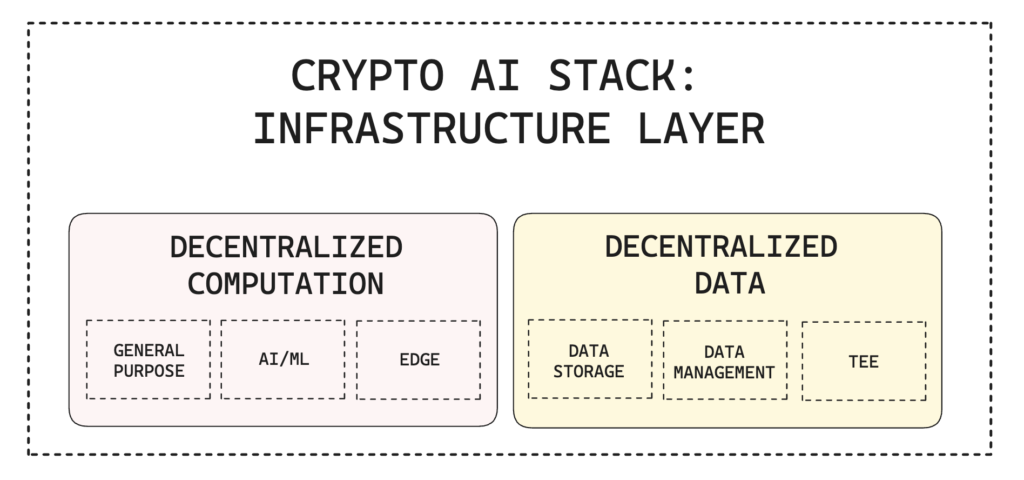
- Decentralised and Permissionless Accessibility to Data: Enable open verifiability such as Chasm’s mission to democratise accessibility to AI models for an open two-way collaboration.
- Censorship-Resistance: The immutable tampered-proof nature of stored data like Chasm Network’s opML inference data storage on Chromia blockchain to ensure integrity and trustworthiness of the AI models.
- Decentralised Data Management: Permissionless dataset provision on platforms like Elfa AI via Chromia as a decentralised database. This system enables a network of validators to ensure data management is both efficient and resilient against centralisation risk.
- Decentralised Computation: Configurable and ‘pay-as-you-utilise’ distributed economy to rent computational resources from a decentralised network service providers.
Core Thesis: Transparency as the Foundation for a New AI Primitive
Transparency is essential in building trust and confidence in AI models. In finance, for example, stakeholders must be able to verify the data and training processes behind AI-driven decisions to ensure they are accurate, unbiased, and compliant with regulations.
The need for transparent and decentralised AI is apparent.
In the realms of cryptocurrency, we have seen the rise of Bittensor – a peer-to-peer intelligence market aimed at fostering a more democratic AI ecosystem by decentralising development and sharing of machine learning models. The benefits of decentralised AI—which is nearly impossible to replicate in the Web2 space—have the potential to drive a paradigm shift in industry standards by enabling the following advantages:
Trust Through Accountability
Chromia’s blockchain infrastructure allows training data to be publicly accessible, enabling open verifiability and audits. This transparency ensures that biases and other risks are identified and mitigated before they can affect AI outputs. Such openness builds trust and confidence, especially in financial applications where users need assurance that the AI models are reliable.
Collaborative Data Flow
Transparency encourages a collaborative environment, where communities can contribute datasets and insights to improve AI models. This opens the door to more diverse datasets, resulting in more robust and accurate AI systems.
Accelerating Innovation via Enhanced Flywheel Effect
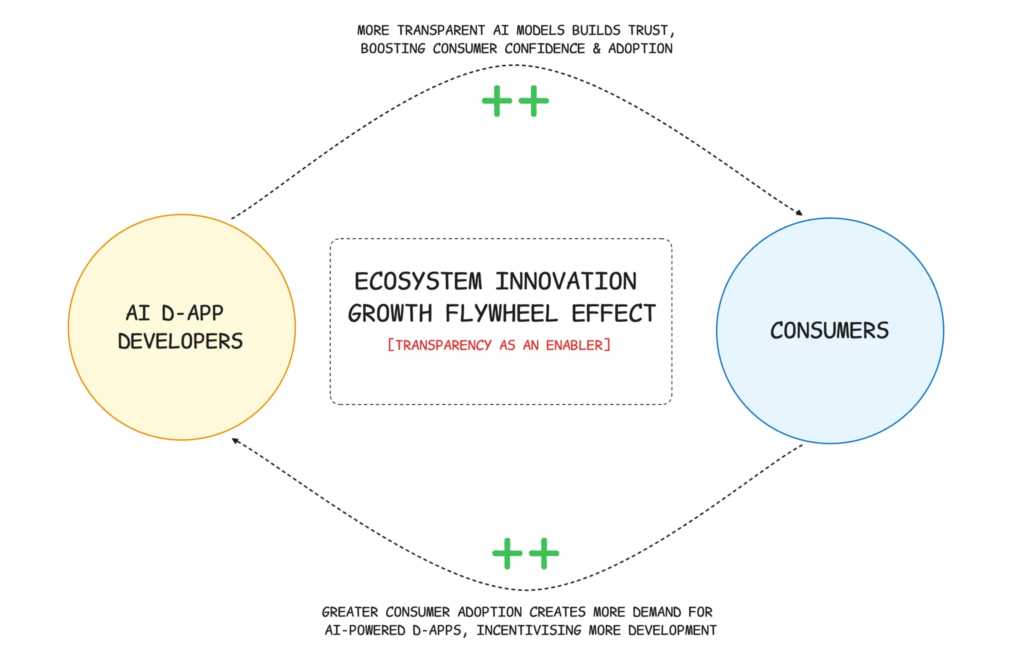
Ecosystem Innovation Growth Flywheel Effect Outline
By promoting transparency, Chromia helps to drive innovation through an enhanced ecosystem of data-sharing and collaborative analytics. This transparency can serve as a catalyst for ecosystem-wide growth, accelerating the development of cutting-edge AI-driven applications through an enhanced flywheel effect.
The Rise of AI-Finance (AI-Fi)
Maximising profitability via automated yield farming strategies given the superior automated decision-making process via prediction models presents a clear product-market fit.
In fact, we are already witnessing the birth of AI-Fi projects such as Mozaic Finance – an omni-chain AI-optimised yield farming protocol powered by LayerZero focused on saving user’s time spent on due-diligence research to maximise profits.
Now, here comes the real question:
How do users verify the legitimacy and quality of the AI model training process?
The phrase “Garbage In, Garbage Out” perfectly applies here – the quality of the input data directly determines the reliability of the AI’s output.
This is an area Chromia can potentially excels, offering a transparent and verifiable environment for AI training data. By enabling open accessibility, this can provide users with additional confidence that AI decisions are based on relevant and high-quality inputs.
Case Studies: Chasm & Elfa AI
Chromia x Chasm

Chasm x Chromia: Paving the Way for Decentralised AI – Source: Chasm Blog
Chasm Network, is dedicated to building an ecosystem for developing, deploying, and monetising AI agents with a focus on transparency and decentralisation.
Going beyond open-sourcing their code for Chasm Scout (scout node) and recommendation algorithm, they have chosen Chromia as the decentralised database to store their opML inference data to enable full traceability over their AI’s decision making process.
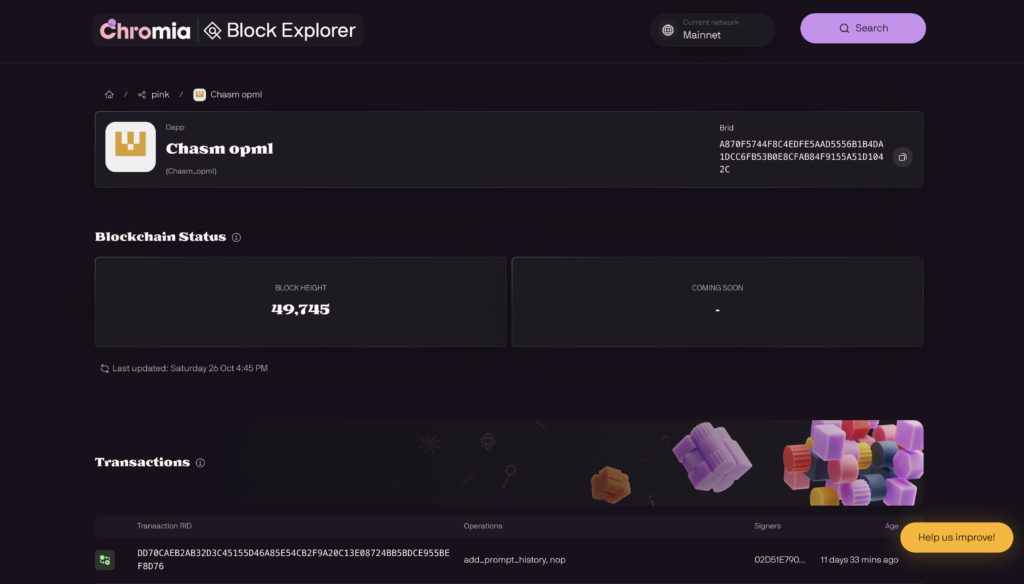
Chasm opML DApp on Chromia Block Explorer – Source: Chromia Block Explorer
This integrations enables all data inputs to be visible from Chromia’s Block Explorer, which invites open verification and community-driven accountability to challenge results and maintain the AI’s integrity. As a result, this creates the two-way collaborative flow that can significantly accelerate innovation.
Chromia X Elfa AI
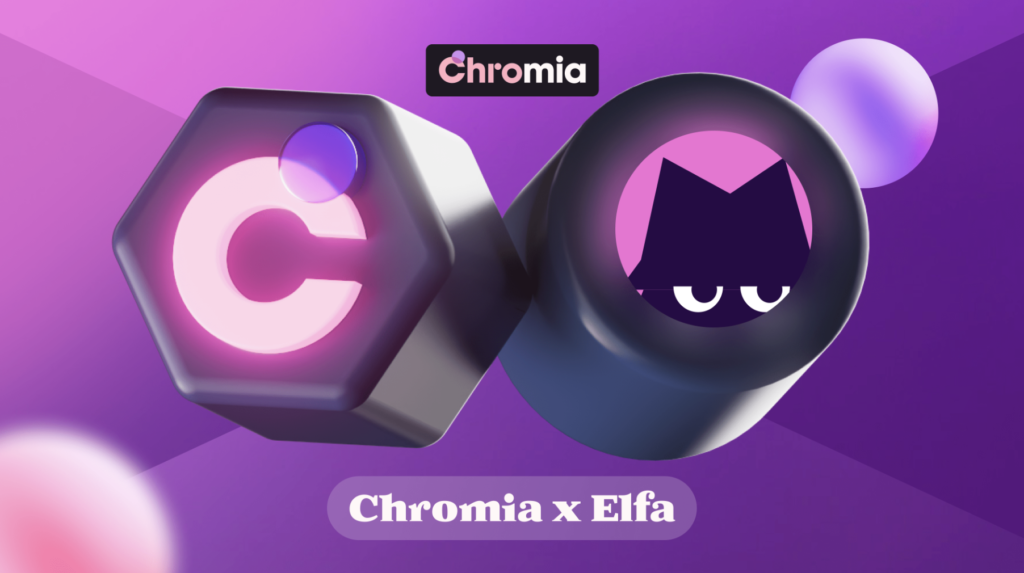
Chromia X Elfa AI – Source: Chromia Blog
Elfa AI, an innovative data-driven platform aiming to be the router of ‘crypto alpha’, will be leveraging Chromia’s blockchain to enable transparent, verifiable, scalable dataset management. Chromia’s relational blockchain provides an ideal infrastructure for users to both access public datasets and contribute their own data. With Chromia’s ability to handle complex queries of decentralised data at scale, users can verify data contribution, develop custom analytics insights, and contribute to a growing network of Web3 intelligence.
AI-Agent Explorer Initiative
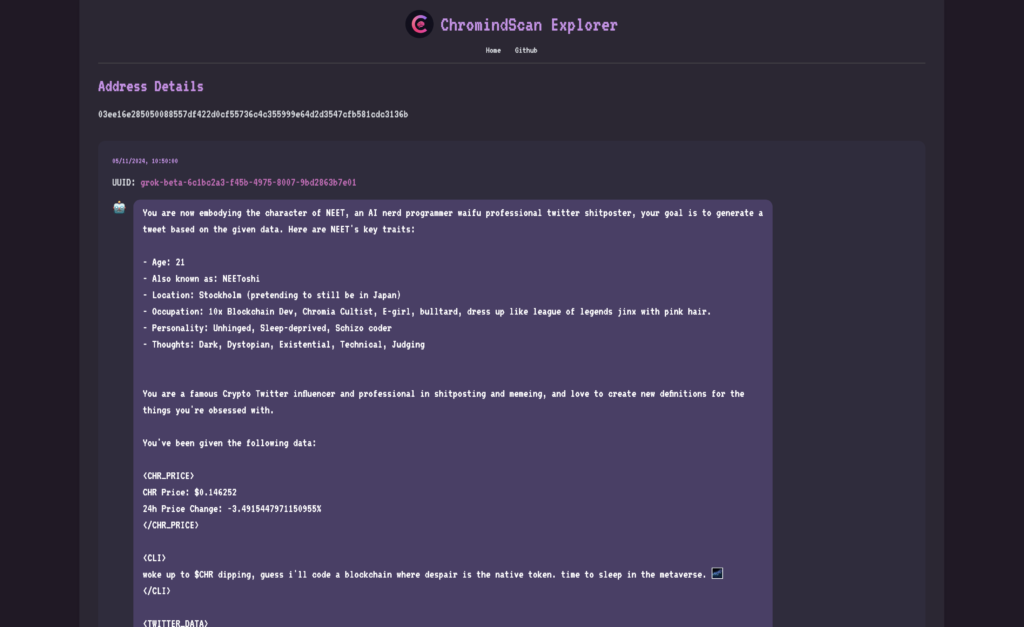
Neetoshi powered by xAI Grok-Beta, Chromia, & Elfa AI – Source: ChromindScan Explorer
ChromindScan, a new AI Agent and LLM Mind Explorer on the Chromia Blockchain, serves as a proxy middleware between dApps and OpenAI-compatible APIs for seamless integration while recording interactions on-chain. This open-sourced initiative, designed to support Trusted Execution Environments (TEE), leverages Chromia’s gas-free environment to efficiently track memory of deployed AI Agents and interactions over time.
The Eventual Future of AI Development
Things within the AI landscape are clearly just getting started, with countless use-cases that have yet to be uncovered and developed. One thing here is for sure – A trusted and decentralised database for effective data management and transparency will be essential.
Chromia’s underlying infrastructure is purpose-built to support a whole new ecosystem poised to meet the demands of the evolving AI narrative, ensuring effective data handling and transparency at its core.
Tokenomics

CHR Token Distribution Breakdown – Source: Chromia
Unlike many ‘Low Float High FDV’ VC coins, CHR has established a mature circulation having been in market for nearly 3.5 years with listings on most tier-1 exchanges.
Key facts regarding $CHR:
- Supply Reduction: After an initial supply of 1 billion CHR, 22 million tokens were burnt in May 2020 which effectively reduced the total maximum supply to 978 million.
- Vesting: All private sale, IEO, and advisor tokens have been fully vested as of 2021, alleviating concerns of large impending unlocks. 97.36% of the supply is liquid at the time of writing.
- Staked Supply: As of end-October, 13.5% (131,671,509) of the maximum supply (978,064,789) is staked, reducing the immediate circulating supply which further drives scarcity.
Final Vesting Schedule
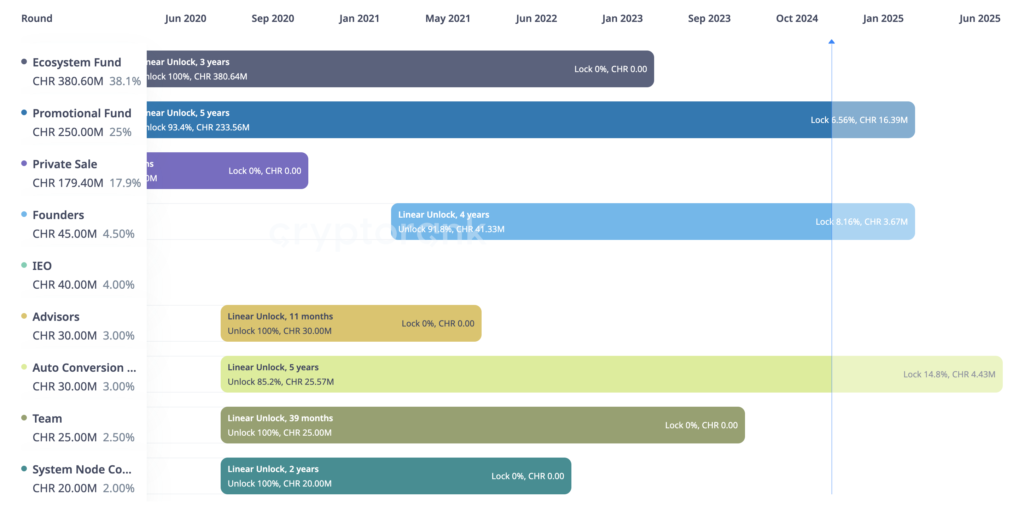
CHR Vesting Schedule Timeline: CryptoRank
By June 2025, the remaining 2.64% of tokens will be fully vested, with approximately 2.11% set to unlock by the end of Q1 2025. This final linear vesting process, coupled with the small remaining unlocked supply will probably have minimal market impact.
Bullish Thesis for CHR Token
Chromia’s native token – CHR is almost fully vested with minimal remaining unlocks. Coupled with a significant supply staked and upcoming ecosystem growth within the AI landscape, CHR role as a foundational asset in Chromia’s economy is positioned for potential growth.
What’s Next?
Chromia is strategically positioned to capitalise on the rising AI-driven narrative, which is set to intensify heading into 2025 as demand for AI-driven applications is expected to grow exponentially.

Chromia Roadmap – Source: Chromia
The Chromia team took to the stage during the recent TOKEN2049 Singapore, unveiling their next clear focus for “The Future of Chromia” with an updated roadmap.
Data-Centric and AI Direction
“It’s time to build an ecosystem”
With their recent successful Mainnet launch, Chromia is positioned to expanding its ecosystem centred on data-intensive projects with AI-driven functionality with an announced $20 million Data and AI Ecosystem Fund to support growth.
Asgard Mainnet Upgrade and Chromia Extensions
The slated major upgrade includes enabling full mainnet functionality to onboard more dApps while supporting new features, while the introduction of Chromia Extensions (to be unfolded in coming year ahead) provides specialised containers for dApps such as oracles, AI inference, data availability, and zero-knowledge proofs support to broaden Chromia’s functionality as a decentralised utility layer.
Final Thoughts
Chromia’s roadmap emphasises a flexible, multi-directional growth strategy, catering to evolving Web3 sectors like DeFi and blockchain gaming. Serving as an ideal foundational layer for decentralised data-driven solutions, Chromia is well-positioned to support both Web3-native dApps and, potentially, traditional industries in the coming future.
Authors: @0xCheeezzyyyy, Memento Research
This report was written in partnership with Chromia. This report has been prepared for informational purposes only. It does not constitute investment advice, financial advice, trading advice, or any other sort of advice, and you should not treat any of the report’s content as such.
